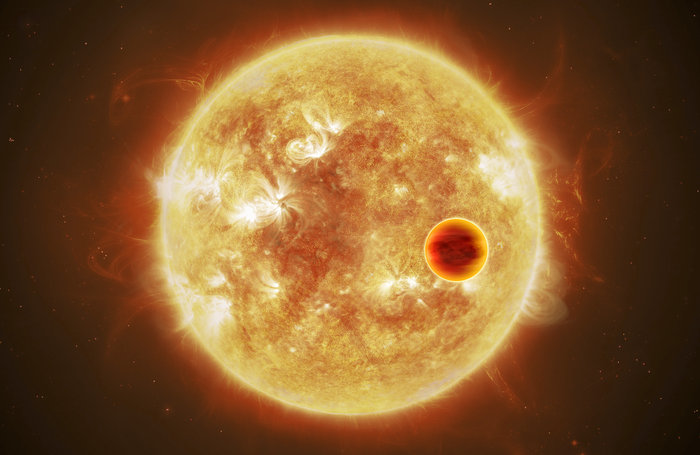Space News & Blog Articles
JWST teases new era in exoplanet astronomy
 NASA’s James Webb Space Telescope has captured the distinct signature of water, along with evidence for clouds and haze, in the atmosphere surrounding a hot, puffy gas giant planet orbiting a distant sun-like star. Credit: NASA, ESA, CSA, STScI
NASA’s James Webb Space Telescope has captured the distinct signature of water, along with evidence for clouds and haze, in the atmosphere surrounding a hot, puffy gas giant planet orbiting a distant sun-like star. Credit: NASA, ESA, CSA, STScI
Among the dazzling images from the James Webb Space Telescope released Tuesday was a squiggly line of spectral data that contained the tell-tale chemical fingerprint of water vapor and clouds in the atmosphere of a scorching hot planet circling a star 1,150 light-years from Earth.
The planet, named WASP-96 b, orbits hellishly close to its sun-like host star in the southern sky constellation Phoenix. It takes just three-and-a-half days to make one lap around its parent star, circling just one-ninth of the distance between Mercury and the sun. Previous measurements indicated WASP-96 b has a temperature higher than 1,800 degrees Fahrenheit (1,000 degrees Celsius).
Astronomers discovered WASP-96 b in a ground-based survey in 2013, and initially thought the planet was free of cloud cover. But Webb’s data suggest otherwise.
Webb found evidence of “clouds and haze” in the atmosphere, NASA said.
WASP-96 b is one of more than 5,000 confirmed exoplanets in the Milky Way. It has half the mass of Jupiter but is 1.2 times larger in diameter, with a “puffy” structure unlike any planet in our solar system.
The Hubble Space Telescope has detected water vapor in an exoplanet atmosphere before, but Webb has the ability to more efficiently measure chemical composition in greater detail.
Stationed in orbit around a gravitationally stable balance point nearly a million miles (1.5 million kilometers) from Earth, the Webb telescope is the largest astronomical observatory ever put into space.
 Artist’s impression of an exoplanet system with a planet transiting in front of its parent star. Credit: ESA/ATG medialab
Artist’s impression of an exoplanet system with a planet transiting in front of its parent star. Credit: ESA/ATG medialab
With a segmented gold-coated primary mirror 21.3 feet (6.5 meters) in diameter, Webb is 100 times more sensitive than Hubble and carries sophisticated detectors to break apart starlight into countless slices like a high-tech prism, allowing sensors to analyze for the chemical composition of distant celestial targets.
Canada’s Near-Infrared Imager and Slitless Spectrograph instrument on Webb measured light from the parent star of WASP-96 b for 6.4 hours as it filtered through the exoplanet’s atmosphere.
The observation “reveals previously hidden details of the atmosphere: the unambiguous signature of water, indications of haze, and evidence of clouds that were thought not to exist based on prior observations,” NASA said in a press release.
“A transmission spectrum is made by comparing starlight filtered through a planet’s atmosphere as it moves across the star to the unfiltered starlight detected when the planet is beside the star,” NASA said. “Researchers are able to detect and measure the abundances of key gases in a planet’s atmosphere based on the absorption pattern – the locations and heights of peaks on the graph.
“In the same way that people have distinctive fingerprints and DNA sequences, atoms and molecules have characteristic patterns of wavelengths that they absorb,” NASA said.
Astronomers can use the spectrum to measure how much water vapor is in the planet’s atmosphere, constsain the abundance of various elements like carbon and oxygen, and estimate the temperature at different levels of the atmosphere, according to NASA. That could yield clues about where and how the planet formed.
Webb is not designed to be a discoverer of exoplanets. Smaller NASA telescopes like Kepler and TESS do that job, allowing JWST to follow up for detailed observations to characterize the alien worlds.
Future exoplanet observations by Webb could reveal the presence of chemical biomarkers, such as ozone and methane, that could be generated by biological processes. NASA said no such signature was immediately obvious with WASP-96 b. No surprise, considering its blazing temperature.
Future targets for Webb include the seven rocky planets of the TRAPPIST-1 system, which orbit a star 40 light-years from Earth, nearly 30 times closer than the WASP-96 b exoplanet. Three of the seven planets around the TRAPPIST-1 star are in the so-called habitable zone, where temperatures could support the presence of liquid water.
Webb will also attempt to directly image the fuzzy reflected starlight from the largest exoplanets, using a coronagraph to blot out the bright shine of the host star.
“There’s a lot more to come,” said Knicole Colón, Webb’s deputy project scientist for exoplanet science at NASA’s Goddard Space Flight Center.
This email address is being protected from spambots. You need JavaScript enabled to view it. the author.
Follow Stephen Clark on Twitter: @StephenClark1.
When you subscribe to the SpaceZE News Feed, we will send you an e-mail when there are new updates on the site so you wouldn't miss them.

